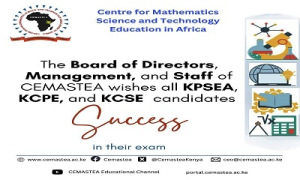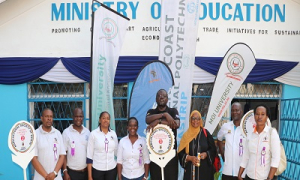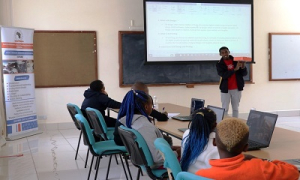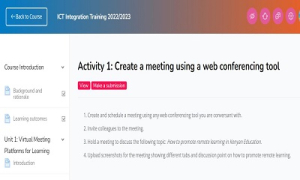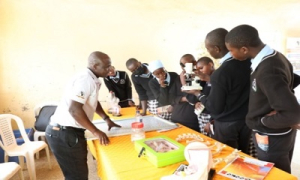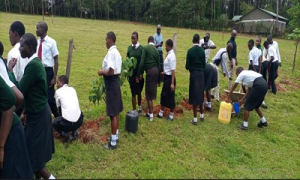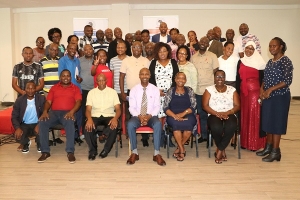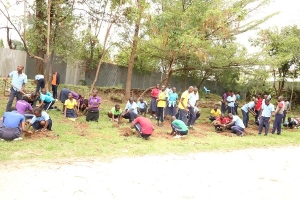Esther Nyambura
The Board of Directors, Management, and Staff of CEMASTEA wishes all Kenya Primary School Education Assessment (KPSEA), Kenya Certificate of Primary Education (KCPE) and Kenya Certificate of Secondary Education (KCSE) candidates success in their examinations.
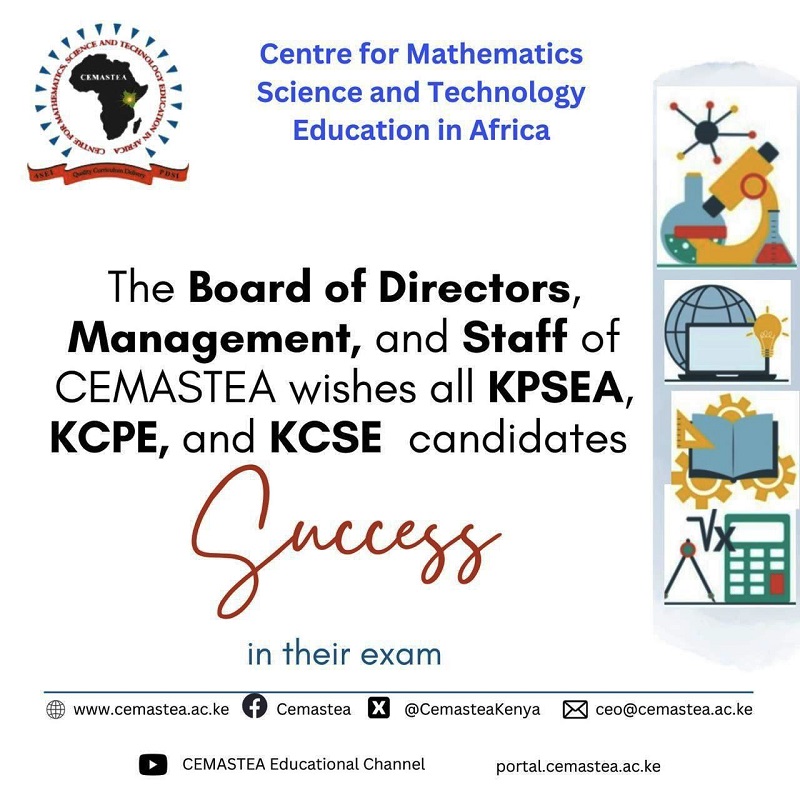
By Makoba Kizito and Winfred Magu
In promoting the spirit of delivering as one, the Ministry of Education (MoE) brought together its affiliated agencies and institutions to exhibit under its stand namely; CEMASTEA, Commission for University Education, Jaramogi Oginga University of Science and Technology, Kenya Coast National Polytechnic, Kwale Teachers Training College, KNATCOM -UNESCO, Moi University and Open University of Kenya. Themed “ Promoting Climate Smart Agriculture and Trade Initiatives for Sustainable Economic Growth’.
The fair provided an excellent opportunity for CEMASTEA to showcase its activities and programmes to the public.
During the event, CEMASTEA engaged members of the public in activities that promoted critical thinking while having fun. This approach was an excellent way to raise awareness about the programmes and activities that the centre offers. By encouraging critical thinking through game based activities, CEMASTEA is instilling a desire for learning in STEM.
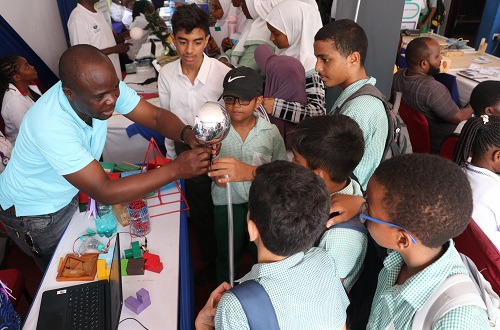
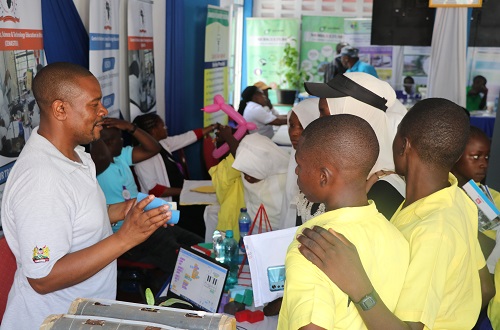
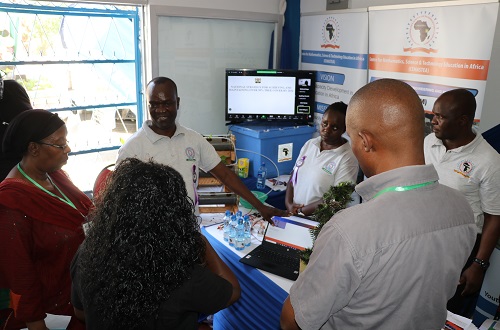

Visitors being taken through some of the teaching and learning resources displayed during the Fair by CEMASTEA Staff
The Ministry of Education won the following awards:
- 2nd position - Best University Stand
- 2nd position - The Stand that best interprets the current show theme education and/or research
- 3rd position - The Stand that best interprets the current show theme education and/or research
CEMASTEA staff poses with the various awards the MoE stand won during the Mombasa International Trade Fair
The awards were a testament to the dedication and hard work that the team had put in to ensure the stand was informative and interactive.
The show took place from 4-10 September, 2023.
#codingislife
CEMASTEA in partnership with STEM Impact Centre have organized the 3rd STEM Boot Camp from August 22nd to August 25th, 2023. With the theme "Igniting the Future: Inspire, Imagine, and Innovate", the boot camp aims to bring together students and learners from Secondary School (Form1-4) and Middle School (Grades 4-8).
The objectives of the Boot camp are to provide an environment for young people to discover their creativity and innovation; encourage more students to pursue STEM related career at tertiary level; enhance students’ creativity and innovation; and promote a community of problem solvers and critical thinkers.
Creative Coding (Basic Coding, Makey Makey, Python, Mobile App Development); Robotics (EV3 LEGO Kit/VEX Kit, Arduino Prototyping); Artificial Intelligence/ Internet of Things- IOT; Graphics Design (3D – Designs; Graphics Designs); and Mathematics and Science Innovations are activities the learners will be taken through.


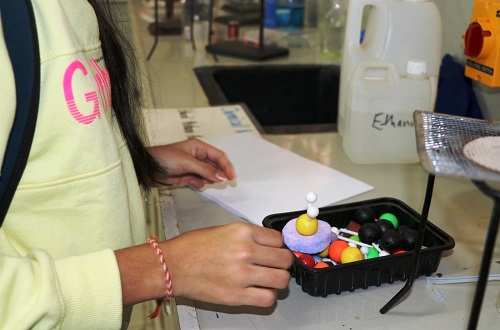
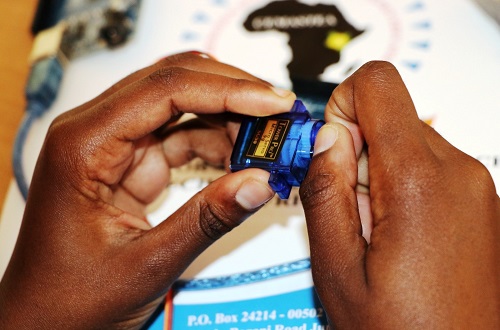
Learners involved in some of the activities in the bootcamp
By Thuo Karanja
During school-based teacher professional development activities, particularly during lesson study, teachers are expected to observe each lesson. A group of biology teachers can collaboratively plan and observe a class implemented by one of them. Pedagogical leaders in a school, such as heads of departments or subject heads, could observe a lesson implemented by teachers in their department. Further, experienced teachers could observe classes implemented by newly recruited teachers during mentoring and coaching. In all these cases, a fundamental expectation is the delivery of feedback. In this article, we focus on the basic tenets of lesson feedback without necessarily getting into the details of pedagogy.
Teachers from Isiolo County collaboratively preparing a lesson
Feedback is a relationship of respect and trust. It is about helping people improve, not about making them feel bad. People want to receive feedback from those they trust. It should not be a senior-junior relationship. Feedback is effective when a teacher knows that the ones giving feedback believe in their abilities, appreciate their current efforts (to plan and implement a lesson) and recognise their growth potential. This way, teachers will most likely view the feedback as constructive and utilise it for improvement. Feedback is better-done face to face. Face-to-face feedback [as opposed to feedback through video conferencing or phone calls] is most effective and dynamic. Face-to-face conversations allow parties to ask questions and dig deeper into the issues at hand and enable contextualising vocal tones, body language and emotions. These are essential aspects of communication.
While a teacher needs to be told the reality of their observed lesson (esp. if one has significant concerns), feedback ought to be presented in a balanced perspective. The observer needs to point out some positives in the lesson, things that impressed you, such as effective learner participation, well-organised and executed lesson activities, logical flow of the lesson or the way a teacher handled a question(s). If some aspects of the lesson did not meet your expectations, frame your discussion to make the teacher feel that; while their current efforts and lesson outcomes are appreciated, there is room for improvement and growth. Focus on specific issues and not generalisations. What was good or needed improvement about the lesson: what did you observe; what was the evidence? Demonstrate to the teacher that you were keen on observing their lesson. With evidence (written notes), tell the teacher what was good and what needs further effort. Don't use statements such as; 'The lesson was nice' [I hear that a lot], 'That was a good lesson', 'great lesson' and 'Nice work'. Suggest to the teacher specific issues and areas to work towards or elements they can focus on replicating. Be truthful [with facts and notes], and don't mislead the teacher into thinking their performance is better than it is. Provide suggestions; 'could you consider doing it this way?‘and avoid using words such as 'never' and 'always' As you make your observations and suggestions, allow the teacher to also talk about their lesson and explain particular perspectives. Please point out the impact of the observations, both positive and negative and how the outcome affects their practice, learner achievement and the well-being of the school.
Do not personalise the feedback; distinguish the teacher ('the person') from their actions and avoid making claims akin to personal attacks. Refrain from using language that is harsh, demeaning or accusatory. Let the teacher know, for example, that you noted some errors in the lesson plan but do not tell them that they lack attention to detail or are careless writers. If a reaction to a learner's response to a question was demeaning, dismissive or disrespectful, point it out from the perspective of its effect on the learner(s). Don't tell the teacher they were rude and abusive to the learner
Finally, feedback needs to be given consistently. It should develop to be a regular practice and pedagogical culture for a school, with expectations, performance standards and indicators. Further, feedback should be timely; delivered immediately after a lesson when ideas are still fresh in the minds of the teacher and the observers. Keep it short and focused on the present and the future. This makes the outcomes of the feedback conversations and outcomes more relevant and actionable. A school could develop lesson observation tools or use existing ones from the Teachers Service Commission (TSC) or from CEMASTEA.
By Paul Waibochi
CEMASTEA has increased by training over 2000 secondary school teachers of all subjects using its Learning management system (LMS) domiciled at the CEMASTEA portal (portal.cemastea.ac.ke). This successful ICT training conducted in 25 Counties had participants self-enrol for the course, work on activities and, after grading and authorisation by the facilitators, download an online certificate. The majority of teachers accessed the system using their mobile phones. This course was self-paced, with teachers doing much of the training on their own time with minimal guidance from the facilitators.
In the past, CEMASTEA has been training teachers on ICT integration in teaching and learning using a blended mode. The centre leveraged virtual platforms such as Zoom, Microsoft Teams, Google Meet, Big Blue Button, and Google Classroom. The LMS can enrol over 100,000 participants doing different courses and simultaneously access learning materials. CEMASTEA plans to use the portal for most of its training programmes.
By BMacharia and DOrero
CEMASTEA has hosted students to participate in cutting-edge learning activities in STEM-related areas. However, the centre can only reach a restricted group of learners. Due to this limitation, the STEM outreach program was launched to enhance the number of schools and learners reached. The programme entails personnel from the centre visiting schools in the Counties and demonstrating innovations in teaching and learning STEM. The Special Programs and Student Learning Committee's STEM outreach and mentorship program has now been incorporated into the Center's core programs.
The outreach programmes are intended to promote a positive attitude towards STEM subjects, bring out the joy and fun of learning, and inspire learners to excel and pursue careers related to Science and mathematics. In each school visited, CEMASTEA showcased activities in Biology, Chemistry, Mathematics, Physics, ICT, Robotics, Education for Sustainable Development (ESD) and Climate change. The hands-on activities students engage in aim to provoke learners' critical thinking, creativity, innovativeness and problem-solving skills. Most of the concepts demonstrated utilise locally available materials that teachers can easily improvise. During the visits, teachers participate in the discussions and take time further to explain science and mathematics concepts to their learners.
The centre has successfully organised visits to several secondary and primary schools across some Counties. In Nakuru County: schools visited were Keriko, Njoro Day, Larmudiac and Mau Narok Secondary Schools; Katoloni, Katelembu, Katheka Kai and Machakos Township Secondary Schools in Machakos County; Ken Obura, St. John's Christostom, Bishop Abiero Shauri Moyo and Lions Day Secondary Schools in Kisumu County. The schools visited in Kakamega County were Kilimo Girls', St. Francis Xavier Shipalo, St. Patrick's Ikonyero, Emetetei and Our Lady of Assumption Shitoli Secondary Schools.
The programme is popular with school leaders, teachers and learners alike. Speaking during the outreach at Bishop Abiero Shauri Moyo Secondary School, Kisumu Central Sub-County Director of Education Mr Charles Ang'iela noted that the outreach programme would reignite interest in Science and mathematics with skills and practical knowledge to boost their performance in STEM subjects. Teachers in the visited schools hailed the programme as an interactive and fun learning approach that captivates learners' interest in STEM subjects.
By PWanjohi and WMagu
Climate change affects many areas of life globally and represents a unique challenge for society—and a unique opportunity for Science, Technology, Engineering, and Math (STEM) education. Effective climate change adaptation strategies could lead to improved resilience of communities most vulnerable to the impacts of climate change. Resilience to climate impacts and mitigation requires scaled efforts at the government, schools and community levels. The Kenya Government is aware of the dangers of not acting now and, led by the President, has set to plant about 15 billion trees in five years. The Government recently launched the "national tree growing and Restoration Campaign" to increase the tree cover in the Country to 30% by 2032. This will go a long way towards mitigating the adverse effects of climate change and promoting entrepreneurship regarding seedlings production.
A tree should never be this lonely
Schools could be the fulcrum around which local communities could start in the development of climate change adaptation strategies. To support the Government efforts, CEMASTEA has committed to establishing a tree nursery and facilitating planting of at least 10,000 tree seedlings by the end of the 2022/23 financial year. Tree planting has been mainstreamed in all primary Center's operations, and a team of officers has been appointed to spearhead implementing the directive. CEMASTEA has been donating and leading tree-planting activities through the STEM outreach program. During these STEM outreach interactions, teachers and students are taken through the principles of Education for Sustainable Development (ESD), Climate change and then engage in a tree planting exercise. To teach the culture of tree planting, students are trained on effective tree planting; hence they appreciate the importance of tree growing and eventually champion similar actions in their local communities.
Students from Shitoli Secondary School in Kakamega planting trees during a STEM outreach activity conducted by CEMASTEA
In this financial year, the centre has donated more than 5,000 tree seedlings in various schools. This includes Kianyaga High School during the Homecoming Ceremony for Deputy President His Excellency Hon. Rigathi Gachagua. The school, which had been termed "Kalahari" owing to the area's dry conditions, planted trees to provide the school community with an inviting climate and increase tree cover.
CEMASTEA plans to establish tree nurseries in at least three (3) schools per County. This is expected to boost the production of quality seedlings that will be planted within the schools and community. The schools will act as resource hubs for educating and sensitising community members on the importance of tree growing and restoration. Every citizen is expected to play a role in achieving this ambitious Government's target. CEMASTEA will continue to play its part in tree growth and repair through Education for Sustainable Development programmes in schools.

